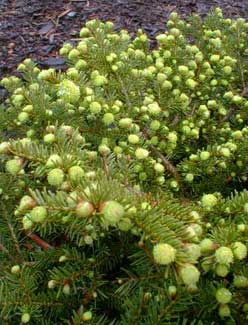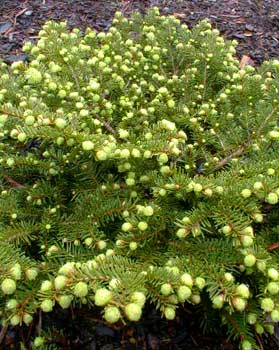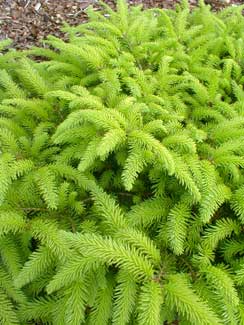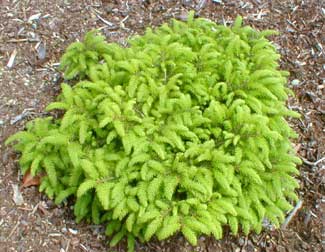
'Little Gem'
Miniature Bird's Nest
Norway Spruce
"Grow, grow, thou little tree."
-Arthur Upson
(1877-1908)
(1877-1908)
The Norway Spruce (Picea abies) grows to sixty feet or more, but P. abies 'Little Gem' Bird's Nest Spruce is a dwarf that mounds to around eighteen inches high in ten years, either rounded, flat-topped, or convexed.
'Little Gem' is also available grafted onto a standard or trunk three feet high, but the specimen I photographed in a friend's garden hugs the ground. It has spread about twenty inches & only five or six inches tall. A young specimen frequently looks like it wants to be a groundcover conifer vaguely like 'Blue Rug' Juniper, but over time it builds up horizontal layers of branches, as though it were striving to be as tall as it is wide.
 A versatile evergreen, bird's nest spruces can be foundation shrubs or specimens for small gardens, part of an array of shrubs for garden edges or rockeries, or container plants.
A versatile evergreen, bird's nest spruces can be foundation shrubs or specimens for small gardens, part of an array of shrubs for garden edges or rockeries, or container plants.Because growth is extremely slow -- as little as one inch a year -- it does not require much in the way of pruning. But it is eminantly trainable for anything from a mini-hedge to a bonzai or something naturalistically in between.
Pruning would be for training & shaping only; there is no requirement to prune any Bird's Nest Spruce, wee 'Little Gem' less than others, as it quite naturally takes on a rather formal appearance.
The overall color is dark green but in April when new growth appears at branch-tips, it is such a light yellow-green that it looks as though the shrub has small yellow flowers all over it. This effect is shown in the two April photos here. By May, as seen in the the third & fourth photos, the whole shrub is again uniformly green.
Definitely hardy for zones three through eight, stretchable to zones two through nine, this miniature spruce requires full sun. It is not fussy about soil conditions so long as it is not soggy or poorly draining, but this specimen is growing near a seasonally very wet roadside gutter, & it seems quite happy even with the occasional wetness.
 An established specimen rarely if ever needs irrigation, except during an extended drought. It can be given a low-nitrogen evergreen fertilizer late winter/early spring, though if never fertilized it'll develop just fine. Bird's Nest spruce has a shallow rootsystem & transplants readily.
An established specimen rarely if ever needs irrigation, except during an extended drought. It can be given a low-nitrogen evergreen fertilizer late winter/early spring, though if never fertilized it'll develop just fine. Bird's Nest spruce has a shallow rootsystem & transplants readily.'Little Gem' originated as a hexen-besen or "witch's broom," which in most cases is a miniature tree that erupts in a branch of a normal-sized parent tree, usually at the site of an injury caused by an insect pest or fungus, though there is no single cause & the entire basis for these occurences is not fully understood.
When this miniature tree is removed from the normal parent tree to root separately, it not remains dwarfed.
Typically something like a gall mite or fungus changes or imitates the character of growth hormones in a tree's branch to trick the tree into bringing the parasite sugared sap. As a side-effect of this activity, a miniature of the host tree is caused to grow at the point of the parasitic injury.
 In a curious double-whammy of witch's brooms, a 'Little Gem' is a bird's nest spruce that developed not on a normal-sized tree, but on another witch's broom -- upon the bird's nest variety called 'Nidiformis.' So a witch's broom already dwarfed produced its own witch's broom doubly miniaturized!
In a curious double-whammy of witch's brooms, a 'Little Gem' is a bird's nest spruce that developed not on a normal-sized tree, but on another witch's broom -- upon the bird's nest variety called 'Nidiformis.' So a witch's broom already dwarfed produced its own witch's broom doubly miniaturized!'Little Gem' is sometimes likened a "sport" of 'Nidiformis,' but being a witch's broom's witch's broom isn't quite like being a sport or mutation in the usual sense.
Witch's brooms if never removed from a host tree cause no particular harm & are generally regarded as benign, & sometimes the underlying cause, such as gall mites, are also fairly innocuous.
But when witch's brooms are removed from the parent tree & rooted or grafted separately, they retain their dwarfed compact structure. Cuttings from such a dwarf grow into the same dwarf form, so they can be produced as garden cultivars.
It's the rare witch's broom that produces cones & fertile seeds, but for any that do do so, the genetic code for miniaturization is carried right into the next generation of the dwarf.